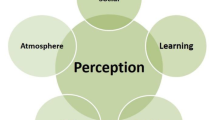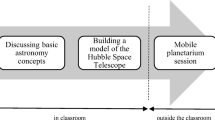Abstract
This study aimed to develop and validate a problem-based learning environment inventory which would help teachers and researchers to better understand student views on problem-based learning environments. The development of the inventory included the following four steps: Item Formulation; Content Validation; Construct Validation; Reliability Calculation. It has 23 items allocated to four scales: (1) Student Interaction and Collaboration; (2) Teacher Support; (3) Student Responsibility; (4) Quality of Problem. Each learning environment item had a factor loading of at least 0.40 with its own scale, and less than 0.40 with all other scales. The results of the factor analysis revealed that the four scales accounted for the 53.72% of the total variance. The alpha reliability coefficient for the four scales ranged from 0.80 to 0.92. According to these findings, the Problem-based Learning Environment Inventory is a valid and reliable instrument that can be used in the field of education.
Similar content being viewed by others
References
Acar S (2004) Analysis of an assessment method for problem-based learning. Eur J Eng Educ 29(2):231–240. doi:10.1080/0304379032000157213
Albanese M, Mitchell S (1993) Problem-based learning: a review of literature on its outcomes and implementation issues. Acad Med 68(1):52–81. doi:10.1097/00001888-199301000-00012
Aldridge JM, Fraser BJ, Huang ITC (1999) Investigating classroom environments in Taiwan and Australia with multiple research methods. J Educ Res 93:48–62
Allan J (1996) Learning outcomes in higher education. Stud High Educ 21:93–108. doi:10.1080/03075079612331381487
Barrows HS (1986) A taxonomy of problem-based learning methods. Med Educ 20:481–486. doi:10.1111/j.1365-2923.1986.tb01386.x
Barrows HS (1996) Problem-based learning in medicine and beyond: a brief overview. Jossey-Bass, San Francisco
Barrows HS, Tamblyn RS (1980) Problem-based learning and approach to medical education. Springer, Berlin
Bartlett MS (1954) A further note on the multiplying factors for various χ² approximations in factor analysis. J R Stat Soc [Ser A] 16:296–298
Bigelow JD (2004) Using problem-based learning to develop skills in solving unstructured problems. J Manage Educ 28:591–609. doi:10.1177/1052562903257310
Boud D, Feletti GI (1997) The challenge of problem-based learning. Kogan Page, London
Buyukozturk S (2002) A handbook of data analysis for social sciences. Pegema, Ankara
Checkly K (1997) Problem-based learning. ASCD Curriculum Update, Summer, 3
Chin C, Chia L (2005) Problem-based learning: using students’ questions to drive knowledge construction. Sci Educ 88(5):707–727
Chiriac EH (2008) A scheme for understanding group processes in problem-based learning. High Educ 55:505–518. doi:10.1007/s10734-007-9071-7
Crocker L, Algina J (1986) Introduction to classical and modern test theory. Harcourt Brace Jovanovich College, Fort Worth
Dahlgren MA, Castensson R, Dahlgren LO (1998) PBL from teachers’ perspective. High Educ 36:437–447. doi:10.1023/A:1003467910288
Driessen E, Van Der Vleuten C (2000) Matching student assessment to problem-based learning: lessons from experience in a law faculty. Stud Contin Educ 22(2):235–248. doi:10.1080/713695731
Fisher DL, Fraser BJ (1981) Validity and use of my class inventory. Sci Educ 65:145–156. doi:10.1002/sce.3730650206
Fraser BJ (1986) Classroom environment. Croom Helm, London
Fraser BJ (1994) Research on classroom and school climate. In: Gabel D (ed) Handbook of research on science teaching and learning. Macmillan, New York, pp 493–541
Fraser BJ (1998) Classroom environment instruments: development, validity and applications. Learn Environ Res 1:7–33. doi:10.1023/A:1009932514731
Fraser BJ (2002a) Preface. In: Goh SC, Khine MS (eds) Studies in educational learning environments: an international perspective. World Scientific, River Edge, pp vii–viii
Fraser BJ (2002b) Learning environments research: yesterday, today and tomorrow. In: Goh SC, Khine MS (eds) Studies in educational learning environments: an international perspective. World Scientific, River Edge, pp 1–25
Fraser BJ, Treagust DF (1986) Validity and use of an instrument for assessing classroom psychosocial environment in higher education. High Educ 15:37–57. doi:10.1007/BF00138091
Fraser BJ, Walberg HJ (eds) (1991) Educational environments: evaluation, antecedents, and consequences. Pergamon, London
Fraser BJ, Anderson GJ, Walberg HJ (1982) Assessment of learning environments: manual for learning environment ınventory (LEI) and my class ınventory (MCI). Western Australian Institute of Technology, Perth
Fraser BJ, Giddings GJ, McRobbie CJ (1995) Evolution and validation of a personal form of an instrument for assessing science laboratory classroom environments. J Res Sci Teach 32:399–422. doi:10.1002/tea.3660320408
Gallagher SA, Stepien WJ, Sher BT, Workman D (1995) Implementing problem-based learning in science classroom. Sch Sci Math 95(3):136–146
George D, Mallery P (2001) SPSS for windows step by step: a simple guide and reference 10.0 update, 3rd edn. Allyn and Bacon, Torontob
Gibson HL, Chase C (2002) Longitudinal impact of an inquiry-based science program on middle school students’ attitudes toward science. Sci Educ 86:693–705. doi:10.1002/sce.10039
Gijbels D, Van de Watering G, Dochy FA, Van der Bossche P (2006) New learning environments and constructivism: the students’ perspective. Instr Sci 34:213–226. doi:10.1007/s11251-005-3347-z
Grasel C, Fischer F, Mandl H (2001) The use of additional information in problem-oriented learning environments. Learn Environ Res 3:287–305. doi:10.1023/A:1011421732004
Greenwald NL (2000) Learning from problems. Sci Teach 67(4):28–32
Habib F, Eshra DK, Weaver J, Newcomer W, O’Donnell C, Neff-Smith M (1999) Problem based learning: a new approach for nursing education in Egypt. J Multicult Nurs Health 5(3):6–11
Hassan MAA, Yusof KM, Hamid MKA, Hassim MH, Aziz AA, Hassan SAHS (2004) A review and survey of problem-based learning application in engineering education, Conference on Engineering Education, Kuala Lumpur, Malaysia
Hendry GD, Ryan G, Harris J (2003) Group problems in problem-based learning. Med Teach 25(6):609–616. doi:10.1080/0142159031000137427
Hmelo-Silver CE (2004) Problem-based learning: what and how do students learn? Educ Psychol Rev 16(3):235–266. doi:10.1023/B:EDPR.0000034022.16470.f3
Hofstein A, Kesner M, Ben-Zvi R (1999) Student perceptions of industrial chemistry classroom learning environments. Learn Environ Res 2:291–306. doi:10.1023/A:1009973908142
Jegede O, Fraser BJ, Fisher DL (1998) The distance and open learning environment scale: its development, validation and use. Paper presented at the annual meeting of the National Association for Research in Science Teaching, San Diego, CA
Johnson DW, Johnson RT, Holubec EJ (1994) Cooperative learning in the classroom. Association for Supervision and Curriculum Development, USA
Kaiser HF (1974) An index of factorial simplicity. Psychometrika 39:31–36. doi:10.1007/BF02291575
Lang QC, Wong AFL, Fraser BJ (2005) Student perceptions of chemistry laboratory environments, student-teacher interactions and attitudes in secondary school gifted education classes in Singapore. Res Sci Educ 35:299–321. doi:10.1007/s11165-005-0093-9
Lindblom-Ylanne S, Pihlajamaki H, Kotkas T (2003) What makes a student group successful? Student-student and student-teacher interaction in a problem-based learning environment. Learn Environ Res 6:59–76. doi:10.1023/A:1022963826128
Macdonald R (2001) Problem-based learning: implications for educational developers. Educ Dev 2(2):1–5
MacDonald R, Savin-Baden M (2003) A briefing on assessment in problem-based learning. LTSN Generic Centre Assessment Series, no. 7, York: LTSN Generic Centre
Mackenzie AM, Jonstone AH, Brown RI (2003) Learning from problem based learning. Univ Chem Educ 7:13–26
Martin-Dunlop C, Fraser BJ (2007) Learning environment and attitudes associated with an innovative science course designed for prospective elementary teachers. Int J Sci Math Educ 6:163–190. doi:10.1007/s10763-007-9070-2
Miller SK (2003) A comparison of student outcomes following problem-based learning: instruction versus traditional lecture learning in a graduate pharmacology course. J Am Acad Nurse Pract 15(12):550–556. doi:10.1111/j.1745-7599.2003.tb00347.x
Moos RH (1974) The social climate scales: an overview. Consulting Psychologists Press, Palo Alto
Moos RH (1979) Evaluating educational environments. Jossey-Bass, San Francisco
Moos RH, Trickett EJ (1974) Classroom environment scale manual. Consulting Psychologists Press, Palo Alto
Norman GR, Schmidt HG (1992) The psychological basis of problem-based learning: a review of the evidence. Acad Med 67:557–565
Nunnally J (1967) Psychometric theory. McGraw Hill, New York
Orion N, Hofstein A, Tamir P, Gidding GJ (1997) Development and validation of an instrument for assessing the learning environment of outdoor science activities. Sci Educ 81:161–171. doi:10.1002/(SICI)1098-237X(199704)81:2<161::AID-SCE3>3.0.CO;2-D
Pellegrino JW, Chudowsky N, Glaser R (eds) (2001) Knowing what students know. National Academy Press, Washington, DC
Peterson RF, Treagust DF (1998) Learning to teach primary science through problem-based learning. Sci Educ 82(2):215–237. doi:10.1002/(SICI)1098-237X(199804)82:2<215::AID-SCE6>3.0.CO;2-H
Polonco R, Calderon P, Delgado F (2004) Effects of a problem-based learning program on engineering students’ academic achievements in a Mexican university. Innov Educ Teach Int 4(2):145–155. doi:10.1080/1470329042000208675
Rentoul AJ, Fraser BJ (1979) Conceptualization of enquiry-based or open classroom learning environments. J Curric Stud 11:233–245. doi:10.1080/0022027790110306
Rideout E, England-Oxford V, Brown B, Fothergill-Bourbonnais F, Ingram C, Benson G, Ross M, Coates A (2002) A comparison of problem-based and conventional curricula in nursing education. Adv Health Sci Educ 7:3–7. doi:10.1023/A:1014534712178
Roth W-R (1994) Experimenting in a constructivist high school physics laboratory. J Res Sci Teach 31:197–223. doi:10.1002/tea.3660310209
Savin-Baden M (2004) Understanding the impact of assessment on students in problem-based learning. Innovations Educ Teach Int 42(2):223–233
Savin-Baden M, Major CH (2004) Foundations of problem-based learning. Society for Research into Higher Education & Open University press, New York
Savin-Baden M, Wilkie K (2004) Challenging research in problem-based learning. Society for Research into Higher Education & Open University press, NY
Schmidt HG (1983) Problem-based learning: rationale and description. Med Educ 17:11–16. doi:10.1111/j.1365-2923.1983.tb01086.x
Senocak E, Taskesenligil Y, Sozbilir M (2007) A study on teaching gases to prospective primary science teachers through problem-based learning. Res Sci Educ 37:279–290. doi:10.1007/s11165-006-9026-5
Soderberg P, Price F (2003) An examination of problem-based teaching and learning in population genetics and evolution using EVOLVE, a computer simulation. Int J Sci Educ 25(1):35–55. doi:10.1080/09500690110095285
Spronken-Smith R (2005) Implementing a problem-based learning approach for teaching research methods in geography. J Geogr High Educ 29(2):203–221. doi:10.1080/03098260500130403
Tabachnick BC, Fidell LS (2001) Using multivariate statistics, 4th edn. Allyn & Bacon, Needham Heights
Tarhan L, Kayali Ayar, Ozturk H, Urek R, Acar B (2008) Problem-based learning in 9th grade chemistry class: intermolecular forces. Res Sci Educ 38:285–300. doi:10.1007/s11165-007-9050-0
Taylor P, Fraser B, Fisher D (1993) Monitoring the development of constructivist learning environments. Paper presented at the annual convention of the National Science Teachers Association, Kansas City, MO
Tsai C (2003) Taiwanese science students’ and teachers’ perceptions of the laboratory learnibg environments: exploring epistemological gaps. Int J Sci Educ 25(7):847–860. doi:10.1080/09500690305031
Tynjala P (1999) Towards expert knowledge? A comparison between a constructivist and a traditional learning environment in the university. Int J Educ Res 31:357–442. doi:10.1016/S0883-0355(99)00012-9
Walberg HJ, Anderson GJ (1968a) Classroom climate and individual learning. J Educ Psychol 59:414–419. doi:10.1037/h0026490
Walberg HJ, Anderson GJ (1968b) The achievement-creativity dimension of classroom climate. J Creat Behav 2:281–291
Walker SL, Fraser BJ (2005) Development and validation of an ınstrument for assessing distance education learning environments in higher education: the distance education learning environments survey (DELES). Learn Environ Res 8:289–308. doi:10.1007/s10984-005-1568-3
Ward JD, Lee CL (2002) A review of problem-based learning. J fam Consum Sci Educ 20(1):16–26
West SA (1992) Problem-based learning—a viable edition for secondary school science. Sch Sci Rev 73(265):47–55
Wong AFL, Fraser BJ (1996) Environment–attitude associations in the chemistry laboratory classroom. Res Sci Technol Educ 14:91–102. doi:10.1080/0263514960140107
Ying Y (2003) Using problem-based teaching and problem-based learning to improve the teaching of electrochemistry. The China Papers July: 42–47
Yuzhi W (2003) Using problem-based learning in teaching analytical chemistry. The China Papers July: 28–33
Author information
Authors and Affiliations
Corresponding author
Appendix
Rights and permissions
About this article
Cite this article
Senocak, E. Development of an Instrument for Assessing Undergraduate Science Students’ Perceptions: The Problem-Based Learning Environment Inventory. J Sci Educ Technol 18, 560–569 (2009). https://doi.org/10.1007/s10956-009-9173-3
Received:
Accepted:
Published:
Issue Date:
DOI: https://doi.org/10.1007/s10956-009-9173-3




